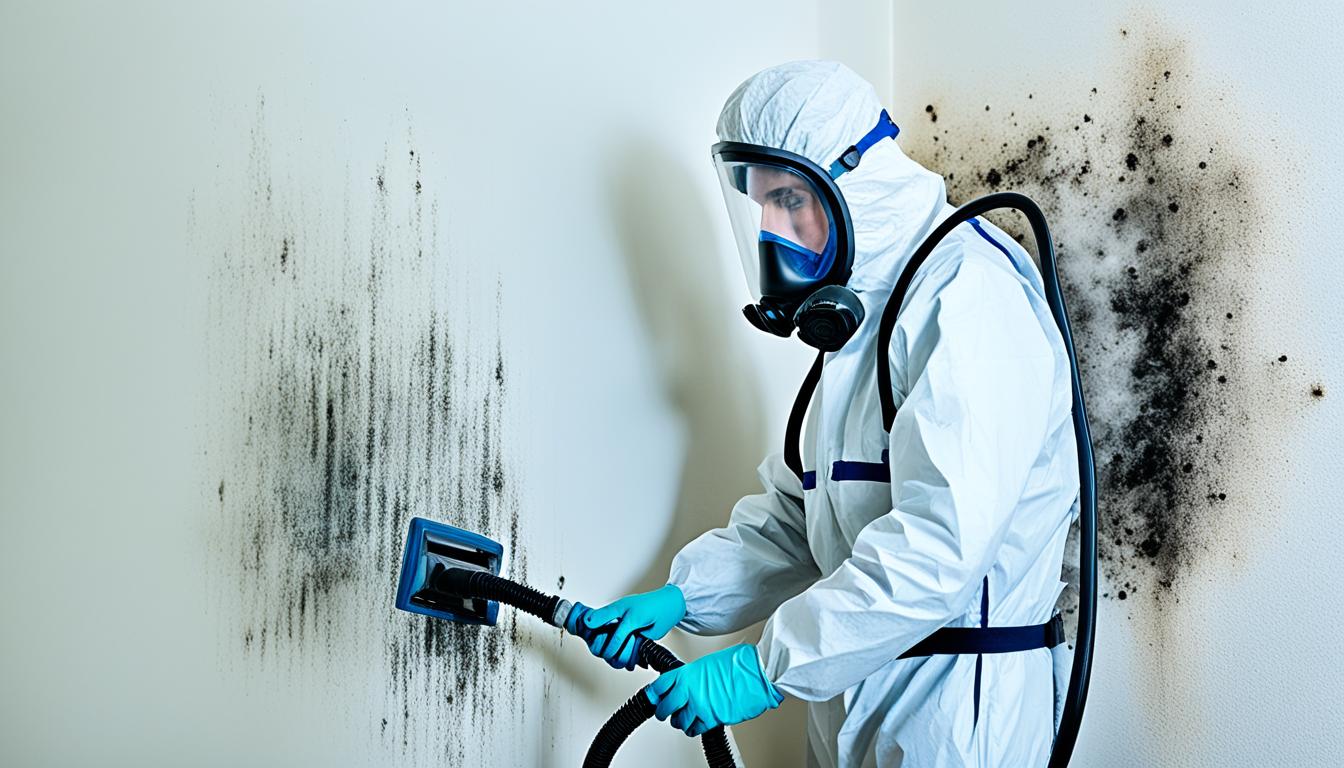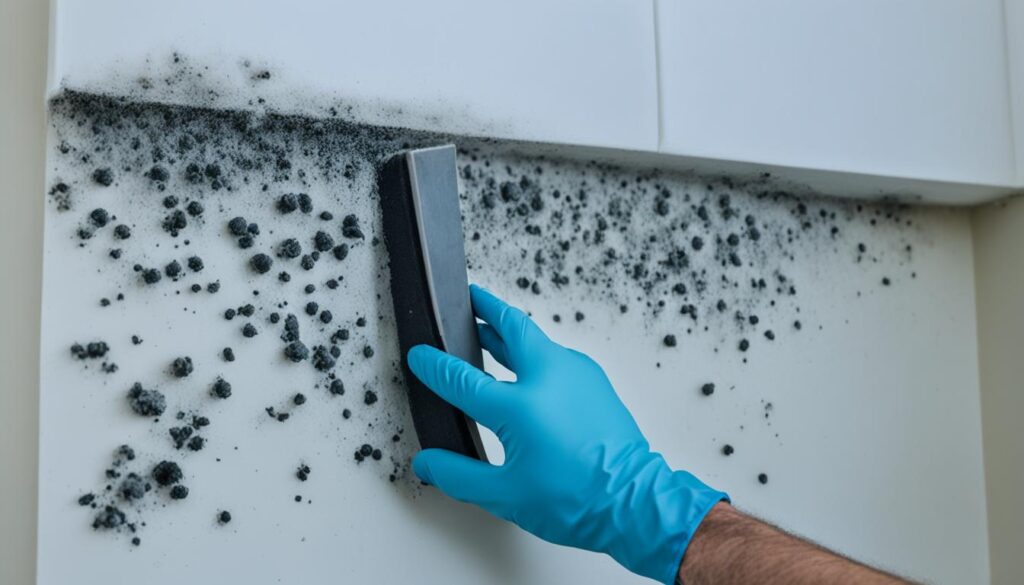
Eliminate Health Risks: Removing Black Mold Safely
Black mold is not only unsightly but can also pose serious health risks to you and your loved ones. Taking proactive measures to remove black mold from your home environment is crucial in safeguarding your health and well-being. In this section, we will discuss the importance of removing black mold and provide expert tips on how to do it safely.
Key Takeaways:
- Black mold can cause severe health hazards if left untreated.
- Removing black mold safely is essential to protect yourself and your family.
- Expert tips and best practices can help you effectively tackle black mold in your home.
- Don’t delay the removal process as prompt action is necessary to prevent further health complications.
- Regular mold assessments and preventive measures are vital to maintain a safe and healthy home environment.
The Dangers of Black Mold Exposure
Black mold exposure can pose serious health hazards, impacting both your physical and respiratory well-being. It is crucial to understand the dangers associated with black mold exposure to protect yourself and your loved ones. Here, we will explore the potential health risks and symptoms linked to black mold exposure, emphasizing the importance of prompt removal to safeguard your health.
Health Hazards:
- Allergies: Black mold can trigger allergic reactions, causing symptoms such as sneezing, coughing, itchy eyes, and nasal congestion. People with asthma or existing respiratory conditions may experience worsened symptoms when exposed to black mold.
- Respiratory Issues: Prolonged exposure to black mold spores can lead to respiratory problems like bronchitis or pneumonia. It can also weaken the immune system, making individuals more susceptible to respiratory infections.
- Toxicity: Certain strains of black mold, such as Stachybotrys chartarum, produce mycotoxins that can be harmful when inhaled. These mycotoxins can cause severe health issues, including neurological problems, organ damage, and in rare cases, even death.
“Black mold exposure should never be underestimated. It can have detrimental effects on your health, especially if you have pre-existing respiratory conditions. Prompt and thorough removal is essential to mitigate the risks and ensure a safe living environment.”
Identifying Symptoms:
- Respiratory Distress: Persistent coughing, wheezing, and shortness of breath can indicate exposure to black mold.
- Allergic Reactions: If you experience unexplained allergic symptoms, such as a runny nose, itchy eyes, or a rash, black mold exposure may be the cause.
- Fatigue and Headaches: Black mold can contribute to chronic fatigue and frequent headaches.
- Neurological Issues: In severe cases, black mold exposure has been linked to memory loss, difficulty concentrating, and confusion.
Conclusion:
Black mold exposure poses significant health hazards and should not be taken lightly. The symptoms and risks associated with black mold exposure highlight the need for immediate removal to protect the well-being of yourself and your family. In the next section, we will explore effective methods for removing black mold to ensure a safe living environment.

Effective Methods for Removing Black Mold
When it comes to removing black mold from your home, it’s essential to use effective methods that not only eliminate the mold but also ensure a safe and healthy environment. Whether you’re dealing with mold on walls, ceilings, or other surfaces, there are several approaches you can take to tackle the problem. Below, we outline different methods that have proven to be successful in removing black mold.
1. Natural Cleaners
One effective method for removing black mold is using natural cleaners. These cleaners are safe for both you and the environment, making them an ideal choice for mold removal. A mixture of vinegar and water, for example, can effectively kill and remove mold from various surfaces. Simply spray the solution onto the affected area, let it sit for a few minutes, and then scrub the mold away with a brush or cloth. Tea tree oil, hydrogen peroxide, and baking soda are also natural cleaners that can be used to remove black mold.
2. Professional Services
In some cases, the severity of the black mold infestation may require professional intervention. Hiring a professional mold removal service ensures that the mold is safely and thoroughly removed from your home. These experts have the knowledge, experience, and equipment to assess the situation, identify the source of the mold, and effectively eliminate it. Professional services not only remove the existing mold but also address the underlying issues to prevent future mold growth.
3. DIY Approaches
For those who prefer a hands-on approach, there are various do-it-yourself (DIY) methods for removing black mold. DIY approaches involve using common household items and following step-by-step instructions to eliminate the mold. For instance, a mixture of bleach and water can be used to clean and disinfect moldy surfaces. However, it’s important to note that bleach should only be used on non-porous materials, as it may not effectively penetrate porous surfaces where the mold may be hiding.
Pro Tip: Whichever method you choose, always remember to wear protective gear such as gloves, goggles, and a mask to prevent direct contact with the mold spores and avoid any potential health hazards.
By utilizing these various methods, you can effectively remove black mold from your home and create a safe living environment. However, it’s crucial to identify the root cause of the mold growth and address any underlying issues to prevent future infestations. Whether you opt for natural cleaners, professional services, or DIY approaches, always prioritize your health and safety throughout the mold removal process.

| Method | Pros | Cons |
|---|---|---|
| Natural Cleaners | – Safe for both the environment and your health – Easily accessible and cost-effective – Versatile and can be used on multiple surfaces |
– May require multiple applications – Less effective on severe mold infestations – Slightly longer removal process |
| Professional Services | – Expert assessment and thorough removal – Addressing underlying issues for prevention – Time-saving and efficient |
– Higher cost compared to DIY methods – May disrupt daily routines during the removal process |
| DIY Approaches | – Cost-effective – Hands-on control over the removal – Immediate action can be taken |
– Requires proper research and knowledge – Potential health hazards if not handled correctly – Effectiveness may vary depending on the severity of the infestation |
Prevention Strategies to Combat Black Mold
Combatting black mold and preventing its growth in your home is crucial for maintaining a safe and healthy living environment. By implementing effective prevention strategies, you can minimize the risk of black mold infestation and protect the well-being of your family. Here are some key prevention measures to consider:
Proper Ventilation
Ensuring adequate ventilation in your home is essential for preventing moisture buildup, which can contribute to black mold growth. Install exhaust fans in bathrooms, kitchens, and laundry rooms to remove excess humidity. Additionally, open windows and use ceiling fans to promote air circulation and reduce moisture levels.
Controlling Moisture Levels
To combat black mold, it’s crucial to address any sources of moisture or dampness in your home. Regularly inspect your plumbing for leaks and repair them promptly. Use dehumidifiers in areas prone to moisture buildup, such as basements and crawl spaces. It’s also advisable to fix roof leaks and ensure proper drainage around your property.
Addressing Water Leaks or Damp Areas
Identifying and addressing water leaks or areas with excessive moisture is vital in preventing black mold growth. Check for water stains on walls, ceilings, and floors, as well as musty odors, as these can indicate hidden sources of moisture. Take immediate action to fix leaks and dry out the affected areas to prevent mold from thriving.
By following these prevention strategies and staying vigilant for signs of moisture or mold growth, you can effectively combat black mold in your home and safeguard the health and well-being of your loved ones.
Conclusion
In conclusion, removing black mold from your home is essential to eliminate potential health risks. The dangers of black mold exposure cannot be underestimated, as it can lead to various health hazards and respiratory issues. By promptly and thoroughly removing black mold, you can create a safe and healthy living environment for you and your family.
It is crucial to adopt effective methods for removing black mold, whether through the use of natural cleaners, professional services, or DIY approaches. Following proper instructions and taking necessary precautions will ensure successful mold removal without further spreading the spores.
Prevention strategies are equally important in combatting black mold. By practicing proactive prevention measures such as maintaining adequate ventilation, controlling moisture levels, and addressing any water leaks or damp areas, you can minimize the risk of mold growth in your home.
Regular mold assessments are key to maintaining a safe and healthy environment. Conducting periodic checks for mold growth and promptly addressing any signs or suspected areas will help prevent the recurrence of black mold and ensure the well-being of your household.




